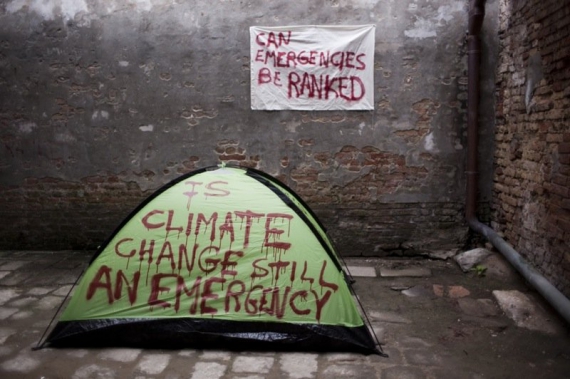1. Maldives pavilion
The Maldives are showing for the first time at this year’s Biennale, showcasing the work of a large number of artists and including installation, painting, sculpture, video and online work. What sets this pavilion apart is their ambition for a first-time exhibitor, with a large number of exhibits as well as live performances in the rear courtyard. The fantastic rabbit-warren venue was also a delight, with every twist and turn revealing another fabulous interior bordering on dereliction.
Chosen by Frances Walsh
2. Portuguese pavilion
Portuguese artist Joana Vasconcelos presents Trafaira Praia, a floating artwork. Wrapped in a blue and white tiled landscape, and covered in cork furnishing, the work transforms a commuter river boat into a glamourous pleasure vessel. Complete with disco and immersive textile installation, the artwork holds a metaphorical finger up to the billionaires’ yachts parked in the Venice lagoon.
Chosen by Nicole Mollett
3. Ragnar Kjartansson – S.S. Hangover
For The Encyclopedic Palace, Kjartansson has created a performance and kinetic sound sculpture, S.S. Hangover, a ship that slowly sails across the waters of the Arsenale as six musicians play a brass composition by Icelandic composer Kjartan Sveinsson. The sound of horns, trombone and tuba create a calming, haunting and ethereal moment. Netherlands madness of the Biennale.
Chosen by Gaynor O’Flynn. Read Gaynor’s Interface review of S.S. Hangover here.
4. Irish pavilion
A mesmerizing, immersive five-screen video installation by Richard Mosse with Trevor Tweeten and Melody London, with music by Ben Frost. Enclave transports the viewer on a voyage through landscapes and warzones in Eastern Congo filmed in infrared, where the colours and narratives create a compelling, hypnotic story of human struggle.
Chosen by Emilia Telese
5. FYR Macedonia pavilion
UK-based, Macedonian artist Elpida Hadzi Vasileva’s work is a moving site-specific installation incorporating thousands of silkworms and albino rats, painstakingly hand treated and woven into a labyrinth of lace-like quality, drawing on the heritage of both her own country and traditional Venetian handicraft. The piece narrates the spread of disease and the exchange of trade in cities like Venice, whilst creating a universal message about the eternal relationship between humans and nature, medicine and disease.
Chosen by Emilia Telese
6. Nicolay Bakharev, The Relationship; Kohei Yoshiyuki, The Park
Included in The Encyclopedic Palace exhibition in the central pavilion of the Giardini, both Bakharev’s and Yoshiyuki’s photographs talk about public nudity and decent/indecent exposure, the former as a liberating, open-air activity by families and lovers in Soviet Russia – where the distribution of photographed nudity was prohibited – and the latter as a sordid, voyeuristic one in Japan – where implied and overt sexual activity takes place in hidden corners. An interesting juxtaposition of classification and intimacy.
Chosen by Emilia Telese
7. American pavilion
Sarah Sze’s wonderfully chaotic installation webs its way inside, out and across the roof of the USA pavilion. Angle-poised lamps, packaged food products, string and tape are just a few of the miscellaneous items she uses to construct finely balanced works, suggestive of industrial sewing machines, mini amphitheatres and the imaginary interiors of globe-like structures.
Chosen by Maurice Carlin
8. Slovenian pavilion
Jasmina Cibic’s total installation, For Our Economy and Culture, draws from an array of historical references and archive material to create a pleasurable art viewing experience within the boudoir-like Slovenian pavilion. It’s not often that an artist can use a word-for-word transcript from a state meeting to create a film that is sensuous, funny and appallingly resonant about the artistic selection process. Many a contemporary selection committee member will be secretly blushing as these archived truisms are brought to life.
Chosen by Pippa Koszerek
9. Kuwaiti pavilion
It would be easy to dismiss the civic statues of Sami Mohammad as formalist state propaganda, however the exhibition is not really about the aesthetic and formal properties of these civic sculptures. We uncover a chilling narrative about the changing relationship between the artist, his artwork, his agency and own personal safety. Also exploring the power dynamics of public space, Tarek Al-Ghoussein’s beautiful and striking photographs convey a sense of stillness and expectation. The artist’s figure is discovered in each image, concealed within the vast architectures, intently looking, experiencing these locations that he has revisited from his own family archive material.
Chosen by Pippa Koszerek
10. Fischli and Weiss – Suddenly This Overview
Part of The Encyclopedic Palace exhibition in the central pavilion of the Giardini, Fischli and Weiss’s Suddenly This Overview (1981-) features hundreds of small clay sculptures, each individually vitrined and plinthed and set at varying heights around the room. It’s a joyfully overwhelming experience moving between them – nothing directly connects any of this stuff, but it all makes sense together, highlighting how we need all of these things to try and make sense of the world. This room, as a single element, seems closest out of anything to representing what an impossible task The Encyclopedic Palace is.
Chosen by S Mark Gubb
11. The Holy See pavilion
This is the first time the Vatican has participated at the Biennale. Slicky delivered on corporate lines, the pavilion offers viewers interpretations of the story of Genesis by four artists working in painting, photography and interactive media. Pop meets a ’90s Athena store – a good starting point for contemplating the idea of original sin, perhaps.
Chosen by Jade Montserrat
The 55th Venice Biennale runs until 24 November.
www.labiennale.org
More on a-n.co.uk:
The Encyclopedic Palace reviewed by Go and see bursary artist S Mark Gubb.
National pavilions and collateral events reviewed by Go and see bursary artists Maurice Carlin.
English Magic reviewed by Go and see bursary artist Frances Walsh.
For latest news from the 55th Venice Biennale use the venice_2013 tag.



